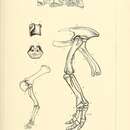pms
nòm ant ël fil


The first partial skeleton of Camptosaurus was discovered by William Harlow Reed in 1879. It was named later that year by Othniel Marsh, originally called Camptonotus, “flexible back (1).” Marsh renamed the genus Camptosaurus in 1885, as the name Camptonotus was already in use by another species (2). Originally, Marsh defined three different species of Camptosaurus, including C. dispar, from specimens collected from Reed Quarry 13. However, it is now recognized that these specimens represent different growth stages of C. dispar rather than unique taxa (3).
Camptosaurus dispar is a beaked dinosaur that lived in the Late Jurassic of Wyoming, approximately 147 million years ago. It could reach 5 m in length and is estimated to have weighed up to 500 kg. C. dispar was an herbivorous browser, feeding on tough vegetation (1). C. dispar was a graceful dinosaur, able to run on its hind legs and reach speeds of 25 km per hour (2). Its arms, though short, were long enough that it could walk quadrupedally (on all four feet), at slow speeds (3). It could have also used its arms to root around in vegetation during feeding (4). C. dispar is considered a primitive member of the group Iguanodontia, which contains Iguanodon and the “duck-billed” hadrosaur dinosaurs (5).
Ecologically speaking, Camptosaurus dispar has often been compared to a deer. C. dispar was herbivorous and browsed on vegetation at low to medium levels. This means it would have fed on ground cover, bushes, and short trees (1). To protect itself from predators such as Allosaurus, C. dispar is thought to have traveled in herds. This is a behavior seen in many other related species of dinosaurs, such as Maiasaura (2). If herding did not provide sufficient defense, the strong rear legs of C. dispar could have allowed it to run to safety, reaching speeds up to 25 km per hour (15 mph) (3).
It is found in the Morrison Formation of Wyoming. When it was alive, the environment was semiarid with a short wet season. This landscape consisted of floodplain prairies and riverine forests (1). Many different species of dinosaurs lived in this habitat, such as the herbivorous Apatosaurus and Stegosaurus, and the predatory Torvosaurus (1).
While similar to modern habitats, C. dispar lived in a very different ecosystem from ones seen today. C. dispar lived in the time before the evolution of flowering plants, meaning that grasses and many other varieties of plants and trees did not exist yet. While mammals are ecologically prominent today, in the Jurassic they played only a small role. The largest mammal in the Morrison Formation was no bigger than a rat (3).
Camptosaurus dispar is a member of Ornithischia, an order of extinct beaked dinosaurs. Within this order are a wide variety of herbivorous dinosaurs, such as Triceratops, Ankylosaurus, and Stegosaurus (1). Ornithischians had more “bird-like” hips rather than the “lizard-hipped” Saurischians (2). Within Ornithischia, C. dispar is classified within the smaller group Ankylopollexia. Other members of Ankylopollexia include Iguanodon and the hadrosaurids, or “duck-billed dinosaurs (3).” Ankylopollexia is defined as the group containing Camptosaurus, Parasaurolophus, and all the descendants of their most recent common ancestor (4). C. dispar is considered a basal member of Ankylopollexia, evolving near the bottom of the evolutionary tree (5).
Currently, C. dispar is the only member of the Camptosaurus genus. However, this has not always been the case. Previously, C. dispar has shared this genus with many species, such as C. medius, C. browni and C. nanus. These were all later determined to be different growth stages or genders of C. dispar, so they were collapsed into one species (6). Another previous Camptosaurus member is Camptosaurus depressus. C. depressus was discovered as a fragment of a skull. It has since been reclassified several times, but is currently considered a member of the Osmakasaurus genus (7).
A fossilized embryo of Camptosaurus was found in the Morrison Formation at Dinosaur National Monument. It is unclear whether this fossil represents an unhatched embryo or recently hatched Camptosaurus juvenile. However, most evidence points towards an unhatched embryo identity. No eggshell was found at the site, but the development of the embryo is consistent with other unhatched dinosaurs previously discovered. The ends of the longbones, the bones making up the limbs, on this embryo are not ossified (not fully developed). This means that Camptosaurus hatchlings would have been poorly suited to take care of themselves upon hatching and most likely had some form of parental care. Other dinosaurs, such as Dryosaurus, appear to hatch with more fully formed bones. This would have allowed them to be more independent (1).
Camptosaurus dispar was an herbivorous dinosaur and browsed at medium and high levels, similar to the feeding patterns of a deer (1). It had many adaptations to suit this lifestyle. It had strong chisel-like teeth lining its upper and lower jaws, designed for crushing tough plant material (2). It was the one of the first dinosaurs with two rows of teeth in each jaw, arranged in an alternating pattern to maximize chewing effectiveness (3). The teeth of specimens of C. dispar show high levels of wear. This further indicates that this dinosaur fed on tough vegetation (4). Instead of teeth at the front of its mouth, it had a beak that could have been useful in plucking plant matter (2).